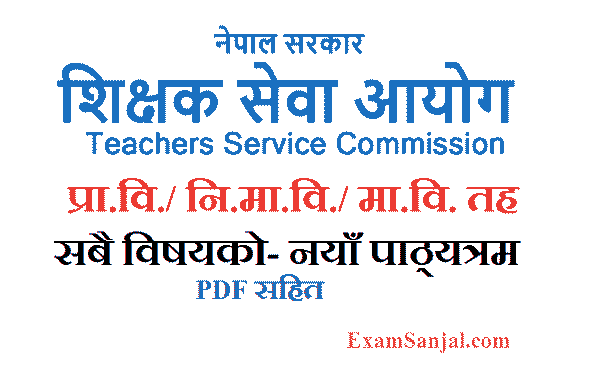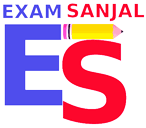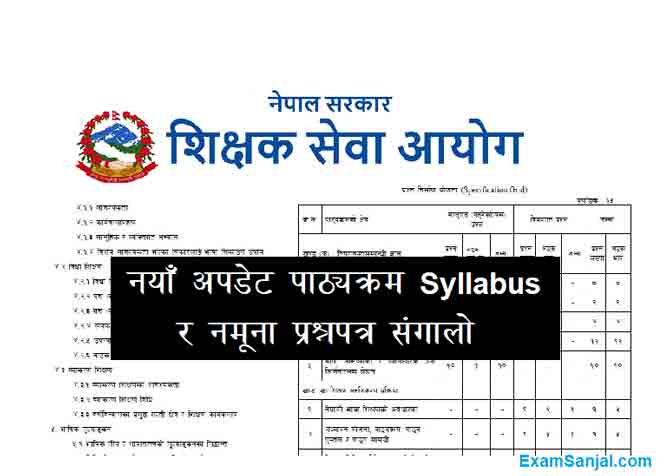Nepali, Social studies, English, Mathematics, Science, Health & Population & all subjects Teacher Service Commission TSC Shikshak Sewa Syllabus. All secondary Level Teacher Service exam syllabus collection.
The teacher Service Commission recently published the teacher job vacancy notice for various posts and levels & subjects. All the subjects teacher & level teacher update syllabus collection are given below.\
Nepali Social English Maths Science Secondary Level Teacher Syllabus TSC Syllabus
Government of Nepal
Teachers Service Commission
Secondary Level Curriculum of Subjective Examination – 2076
Subject: English Full Marks: 100 Time: 3 Hours
Section: A
Unit 1: Teaching and Testing Oral Skills and Language Functions
1.1. Teaching listening skills
1.2. Teaching speaking skills
1.3. Teaching language functions
1.4. Testing oral skills
1.5. Testing language functions
Unit 2: Teaching and Testing Written English
2.1. Teaching reading skills
2.2. Teaching writing skills
2.3. Preparing instruments for testing reading and writing skills
2.4. Scoring answers in reading and writing tests
2.5. Teaching and testing literary texts
Unit 3: Teaching and Testing Aspects of English Language
3.1. Teaching grammar
3.2. Teaching vocabulary
3.3. Teaching pronunciation
3.4. Teaching punctuation
3.5. Testing grammar, vocabulary, pronunciation, punctuation and sounds
Unit 4: Planning and Designing Teaching Materials
4.1. Lesson planning, managing time and activities
4.2. Designing and constructing visual materials
4.3. Use of audio-visual materials
4.4. Preparing operational calendar and subject specific annual plan
4.5. Use of ICT tools in language teaching
Unit 5: Overview of English Language Curriculum of Secondary Level
5.1. English curriculum, Textbooks and Teachers guide of grade 9 -12
5.2. Use of supplementary materials (dictionary, grammar books, newspapers, charts etc.)
5.3. English language testing system and specification grid
5.4. Correction of Error and Error analysis
Section: B
Unit 6: Theoretical Concepts of Language Learning and Teaching
6.1. Theories of language learning
6.2. Approaches, methods of language teaching
6.3. Language teaching techniques and activities
6.4. Relationship between linguistics and language teaching
6.5. Application of different approaches, methods and techniques in English as a Foreign
Language (EFL) classroom
Unit 7: Literature for Language Development
7.1. Introduction and history of English literature
7.2. Genres of English literature
7.3. Figures of speech
7.4. Reasons for teaching literature
7.5. Techniques and strategies for teaching literature
Unit 8: Professional Development of English Language Teachers
8.1. Types and models of professional development
8.2. Strategies of professional development
8.3. Maintaining professional ethics
8.4. Building networking, collaboration and cooperation in professional learning
8.5. Values of teaching profession
Unit 9: Reading and Writing in Language Education
9.1. Reading and extracting appropriate information
9.2. Reading for academic purpose
9.3. Mechanics of writing
9.4. Developing skills in writing: Selecting key points, note-making, paraphrasing,
summarizing, planning, editing and drafting and revising
9.5. Choice of academic vocabulary in writing
Unit 10: Research in English as a Foreign Language (EFL) Context
10.1. Introduction to research in language pedagogy
10.2. Application of research in language teaching-learning
10.3. Design and types of research in language teaching
10.4. Drawing conclusions, implications and giving recommendations from research
10.5. Academic writing in research
- First Paper Objective Secondary Level TSC Teacher Service Exam Syllabus
- Nepali Subject Secondary Level TSC Teacher Service Exam Syllabus
- Social Studies Subject Secondary Level TSC Teacher Service Exam Syllabus
- English Subject Secondary Level TSC Teacher Service Exam Syllabus
- Maths Subject Secondary Level TSC Teacher Service Exam Syllabus
- Science Subject Secondary Level TSC Teacher Service Exam Syllabus
Maths Mathematics Subject Teacher Service TSC Syllabus Secondary Level
Subject: Mathematics
Level: Secondary Level Teacher Service TSC Syllabus
Section A
Unit 1: Teaching Arithmetic
1.1. Set theory: Set and notations, Relation between sets, Operations on sets, Algebra of sets, Venn-Diagrams and related problems
1.2. Percentage and Application: Money Exchange, Discount and VAT, Profit and loss, Home arithmetic
1.3. Sequence and Series: Arithmetic, Geometric and Harmonic sequence and series, nth term and sum, A.M, G.M, H.M and their relations
1.4. Investment and Growth: Compound interest, Compound depreciation, Population growth
1.5. Mensuration: Area of triangle, Area and volume of prism, Area and volume of cylinder and sphere, Area and volume of pyramid and cone, Cost and estimation
Unit 2: Teaching Algebra and Geometry
2.1. School Algebra: Algebraic Expressions, Radical and surds, Polynomials and rationales, Indices, Linear and quadratic equation
2.2. Geometry: Triangle, Quadrilateral, Circle, Tangent to Circle, Construction
2.3. Analytic Geometry: Straight line, Homogeneous equation, Pair of lines, Angle between two lines.
2.4. Transformation Geometry: Reflection, Rotation, Translation and Enlargement
2.5. Vector and Scalar: Definitions, Scalar product, Vector product, Application vector in geometry
Unit 3: Teaching Pre-Calculus
3.1. Matrices and Determinants: Definition of matrix, Transpose and inverse, Determinants of 2×2 and 3×3 matrix, Properties of determinants and problems, Solution of system of linear equation (Cramer’s rule)
3.2. Linear Programming, Function and Graph: Graphical, Simplex Method, Odd and even functions, Symmetry (about origin, X-axis and Y-axis), Sketching graphs of quadratic function
3.3. Trigonometry: Unit, circle, algebric, Trigonometric, exponential and their graph, composite and inverse function.Trigonometric identities, general values, solution of triangles and inverse functions
3.4. Complex Number: Definition, Absolute value, Conjugate, Algebra of complex number, De- Moivre’s theorem
3.5. Conic Section: Definition, Ellipse, Parabola and Hyperbola (standard equation and example)
Unit 4: Teaching Statistics
4.1. Counting Principles and Induction: Counting principle, permutation, combination, mathematical induction
4.2. Probability: Mathematical expectation, conditional probability, Bayes’ theorem.
4.3. Measures of Central Tendency: Mean, Median, Mode, Relations among them
4.4. Measure of Dispersion: Range and Quartile deviation, Mean deviation, Standard deviation, Coefficient of variation.
4.5. Correlation and Regression: Correlation coefficient and its properties, Pearson’s correlation, Spearman’s correlation, Regression equations of two variables
Unit 5: Overview of Mathematics Curriculum of Secondary Level
5.1. Curriculum and Textbook: Comparative study of mathematics curriculum, Textbooks and Teachers guide of grade 9 -12
5.2. Teaching Materials: Development and use of of teaching and supplementary materials in mathematics teaching
5.3. Evaluation and Testing: Testing and and evaluation in mathematics teaching, specification grid
5.4. Assessment: Continuous assessment system, grading system in student assessment,
5.5. Error analysis: Correction of error and error analysis
Section B
Unit 6: Calculus and Mechanics
6.1. Limit and Continuity: Meaning of x→a, Limit of a function, Left hand and right-hand limit, Continuities and discontinuities of a function.
6.2. Derivative: Derivative and its geometrical meaning (slope of tangent), Techniques of differentiation, Application of derivative (Maxima/Minima, increasing/decreasing, concavity), Rolle’s and Mean value theorem.
6.3. Integration: Definition, Techniques of integrations (substitutions, by parts), Fundamental theorem of calculus, Application of integration (area, volume)
6.4. Numerical Interpolation: Interpolation, numerical differentiation numerical integration
6.5. Dynamics and Statics: Introduction, Mechanics, Law of forces, Resultant forces and equilibrium forces.
Unit 7: Geometry and Differential Equation
7.1. Euclidean Geometry and its Elements: Introduction to Euclidian Geometry, Fifth postulates, Foundations, Congruence, Similarity7.2. Non-Euclidean Geometry: Shortcomings of Euclidean Geometry, Discovery of Non- Euclidean Geometry, Elliptic Geometry, Hyperbolic Geometry, Comparison among three geometries
7.3. Three-Dimensional Geometry: Coordinate System, Direction cosines/ratios, Equation of straight line
7.4. Surface Topology: Polyhedron, Euler’s Formula, Euler’s characteristics for surface, Orientability of surface and four color problems
7.5. Differential Equation: Order and degree, First order first degree equation, Method of variable separable, Homogenous equation
Unit 8: History of Mathematics and Geometric Transformation
8.1. Numeration System: Egyptian, Babylonian, Roman, Hindu-Arabic and Devanagari, Characteristics of the numeration system
8.2. History of Mathematics: The problems of Antiquity, Medieval mathematics, Modern mathematics
8.3. Isometric Transformation: Reflection, rotation, half turn and glide reflection and derivation
8.4. Non-Isometric Transformation: Enlargement and reduction and derivation
Unit 9: Probability
9.1. Joint Probabilty Dostribution: Marginal and conditional distribution, moment and moment generating function.
9.2. Discrete Probability Distribution: Binomial, poison, hypergeometric distribution (Derivation of mean, variance, moment generating function)
9.3. Continous Probability Distribution: Normal distribution, beta and gamma distribution.
9.4. Hypothesis Testig: Introduction, types of error, critical value and significance level. T- test and Z-test.
9.5. Non-Parametric Test: Introduction and application, sign test, rank test, H- test and test of randomness.
Unit 10: Recent Trends in Mathematics Education
10.1. Philosophy of Mathematics Education: Introduction and its components, Foundations of mathematics education, components and shift in philosophy.
10.2. Learning Theories of Mathematics Education: Three major schools of thoughts (Behaviorist, Cognitivist & Constructivist), Major contributions of major theorists (Piaget and Bruner )
10.3. Trends in Mathematics Education: Objectives and contents, Methods and materials, Students’ and Teachers’ role, Assessments, Research in mathematics
10.4. Issues of Mathematics Education: Introduction, Teaching and learning, Assessment of mathematics, Culture of mathematics teaching
10.5. ICT in Mathematics Education: Introduction, Use of ICT tools to explore mathematical knowledge, Models on Teaching mathematics using ICTs
Account Office Management Economics Computer Health Population education Sanskrit Syllabus Secondary Level Teacher
- Account Lekha Office Mgmt Subject Secondary Level TSC Teacher Service Exam Syllabus
- Economics Subject Secondary Level TSC Teacher Service Exam Syllabus
- Health Population Edu Subject Secondary Level TSC Teacher Service Exam Syllabus
- Computer Science Subject Secondary Level TSC Teacher Service Exam Syllabus
- Education Shiksha Subject Secondary Level TSC Teacher Service Exam Syllabus
- Sanskrit Sanskrit Bhasa Subject Secondary Level TSC Teacher Service Exam Syllabus
- Click here to View All the Syllabus of TSC Teacher Service Commission Exam
=> View All Syllabus Collection Model Questions at TSC Teacher Service Folder
=> Click Here to View Primary & Lower Secondary Syllabus of Teacher Service Commission Exam
TSC Admit Card Print Download Online- Shikshak Sewa Prabesh Patra Print
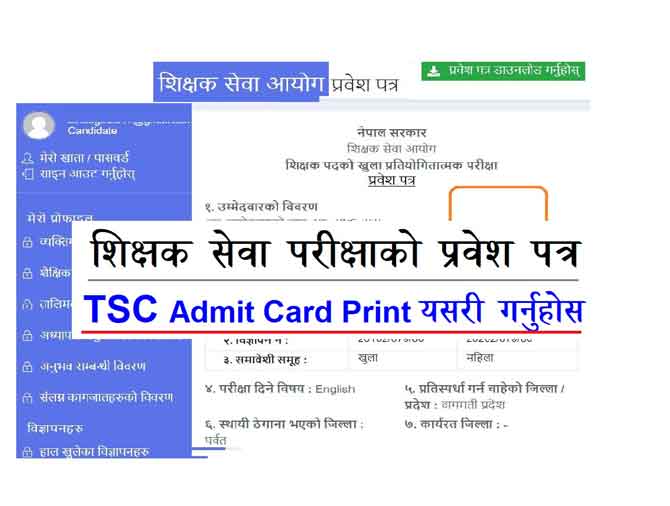
Retired Teacher Lists 2079 to 2080 Aniwarya Abakash Shikshak Teacher Name lists
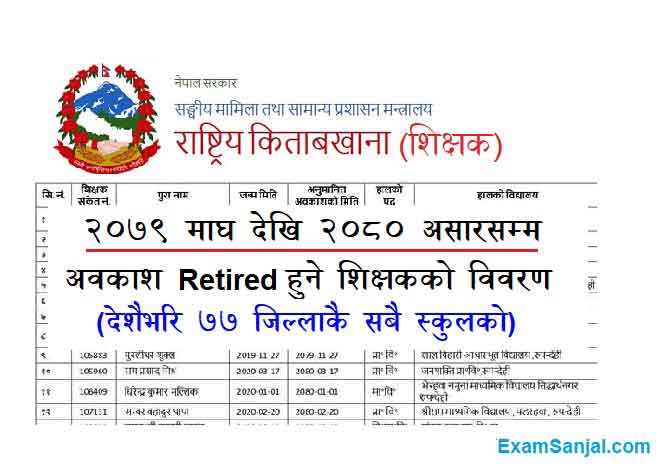
TSC Teacher Vacancy Exam Result Routine Schedule by TSC
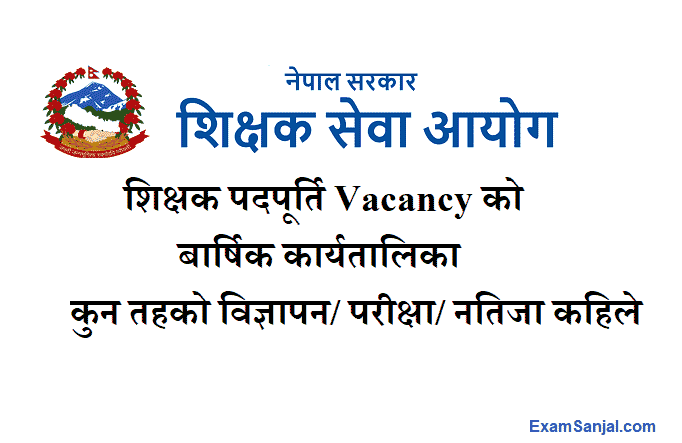
Teacher Karar Name Lists Contract Teacher TSC Lists
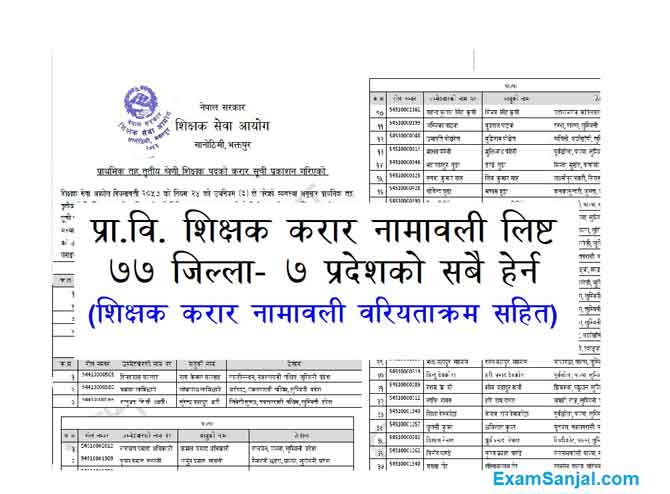
Teacher Karar Name lists of Mabi Nimabi Level Teacher
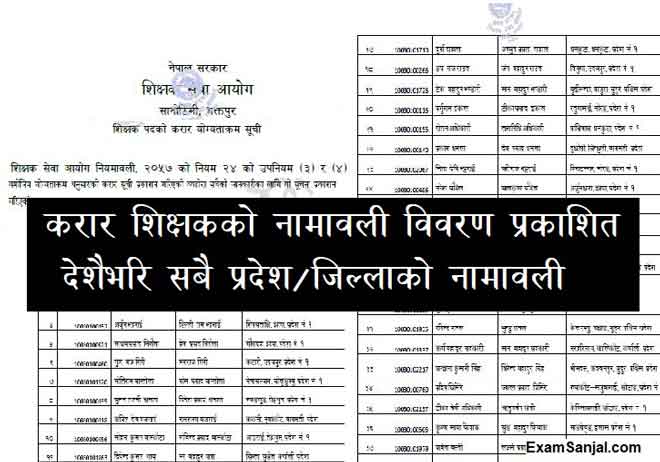
View TSC License Important Questions Paper with Answer Key- Click Below
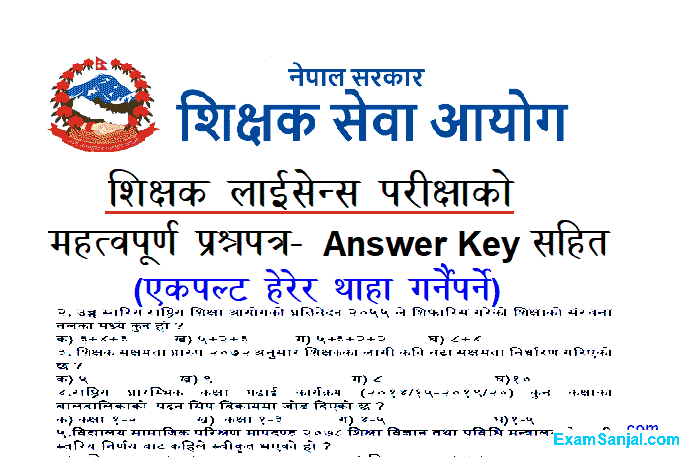
TSC License Exam Syllabus Teaching License New Syllabus Pathyakram
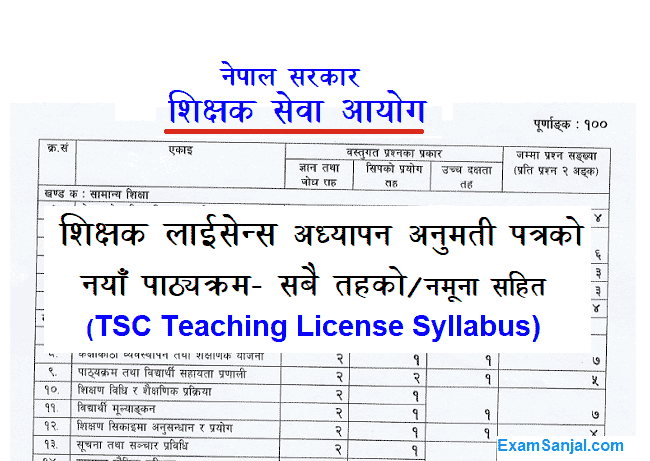
TSC Exam Most Important Model Questions Paper with Answer Sheet
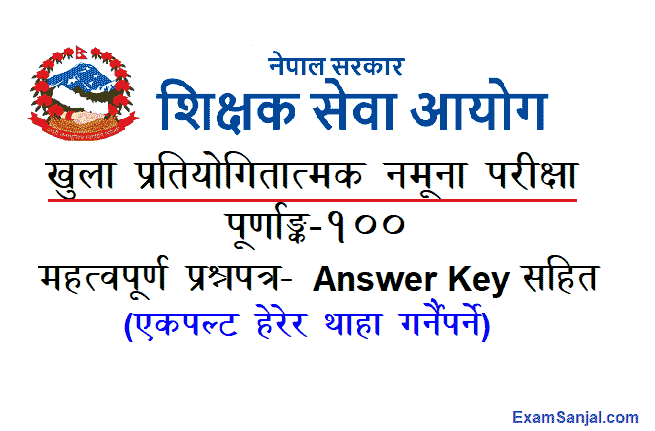
TSC Exam First Paper Answer Sheet Writing Guideline by TSC- How To Write TSC Exam Paper
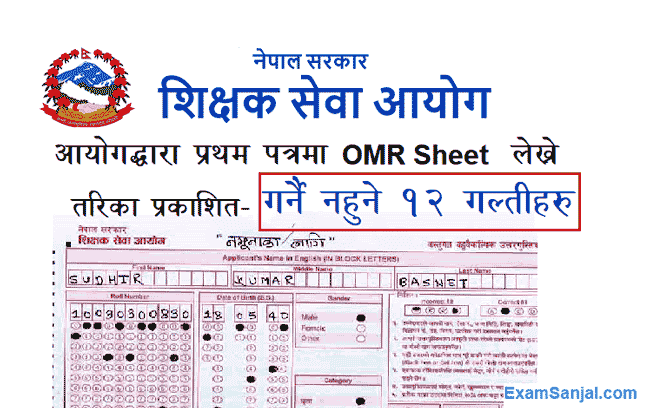
TSC Model Questions Collection Teacher Service Exam Model Question paper Collection
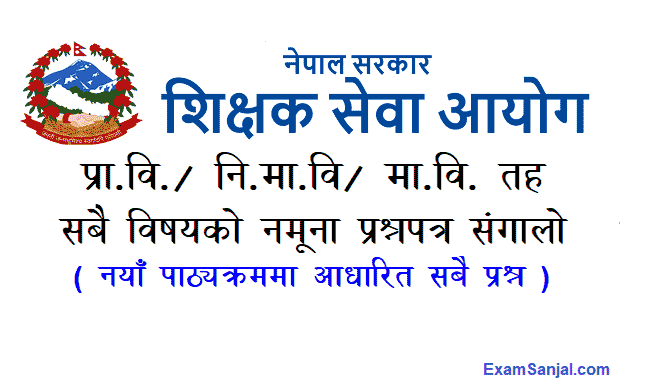
TSC Teacher Service Exam Syllabus of All Level TSC Syllabus
